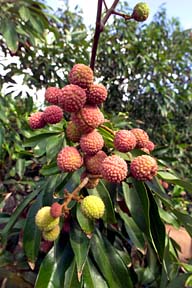
Eleanor Nakama-Mitsunaga

|
Lychee trees around town are exploding with fruit. It's lychee season, and from the look of the trees in my neighborhood, it seems like a bumper crop.The basics: Lychee, also known as litchi nut, is the fruit of a large tree in the soapberry family, which includes longan and rambutan. The tree is native to Southern China, where it has been cultivated for thousands of years and is very endeared.
Lychee trees have a lifespan of hundreds of years and thrive in subtropical climates such as Hawaii. Lychee was introduced to Hawaii sometime in the late 1800s and at one time the trees were a common sight in most neighborhoods. The fruit is now commercially grown in Hawaii, Florida and California.
The many varieties of lychee differ slightly in taste and texture. But all are a good source of vitamin C.
The nearly round fruit grow in clusters and turn bright red when ripe. Lychee has a rough, leathery skin that needs to be peeled before consuming. Inside is a juicy, translucent white fruit that is oh-so-sweet and fragrant.
The hard center pit of the fruit is inedible and, depending on variety, may be large and smooth to small and shriveled (also called the "chicken tongue" variety. Selecting: Look for fruit that is firm, plump and bright red in color. Watch out for brown spots, splits in the skin or moldy fruit. Brown, dried-out skin also indicates age or possible dryness.
Storing: Lychee can be stored unpeeled in the refrigerator for one to two weeks.
Use: The best way to enjoy lychee is freshly peeled and popped in the mouth. Lychee can also be added to fruit salads or enjoyed with almond float gelatin. Canned lychee is an alternative and comes already pitted. But save the canned for the off-season.
Where to buy: Fresh lychee will only be available through July. Commercially grown lychee is available in supermarkets for around $5 a pound. Or, this is a good time to make friends with neighbors who may want to share a bountiful crop.
Eleanor Nakama-Mitsunaga is
a free-lance food writer. Contact her
online through features@starbulletin.com

